Comprehensive Analysis: Maritime Shipping Industry Dynamics
VerifiedAdded on 2020/04/21
|21
|4704
|39
Report
AI Summary
This report provides a comprehensive analysis of the maritime shipping industry, exploring the factors that influence demand and supply in the global freight market. It examines various types of shipping freights, including container cargo, liquid bulk, dry bulk, break bulk, and Ro-Ro, and analyzes cargo-related, vessel-related, sailing-related, and port-related issues. The report delves into the tramp freight market, discussing freight rate formation, contracts of affreightment, and the differences between freight and hire. Furthermore, it applies momentary, short-run, and long-run equilibrium models to understand market dynamics. Data and insights are drawn from reliable sources, including the European Union, the Baltic Dry Exchange, and the World Shipping Council, to provide a robust understanding of the industry.
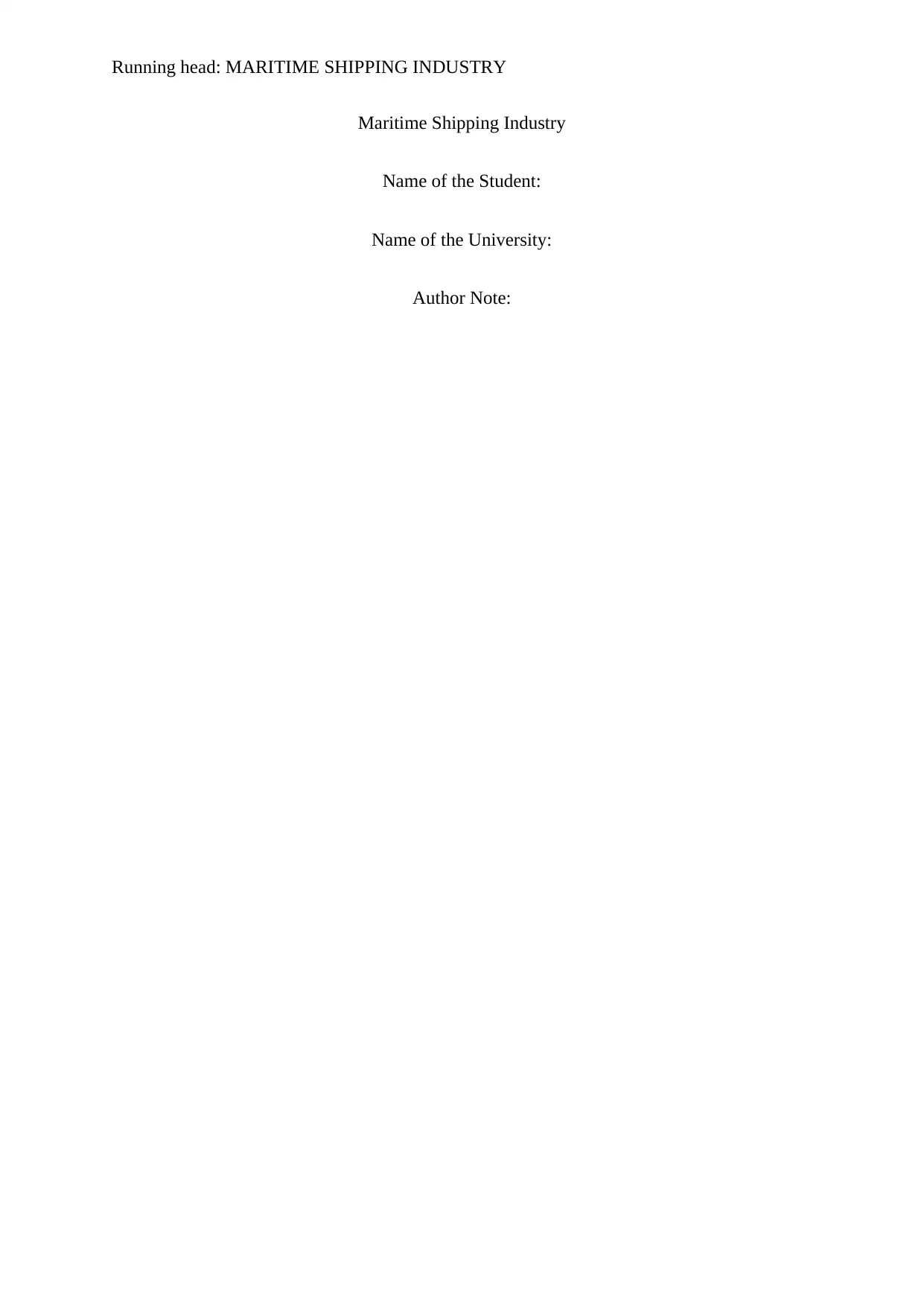
Running head: MARITIME SHIPPING INDUSTRY
Maritime Shipping Industry
Name of the Student:
Name of the University:
Author Note:
Maritime Shipping Industry
Name of the Student:
Name of the University:
Author Note:
Paraphrase This Document
Need a fresh take? Get an instant paraphrase of this document with our AI Paraphraser
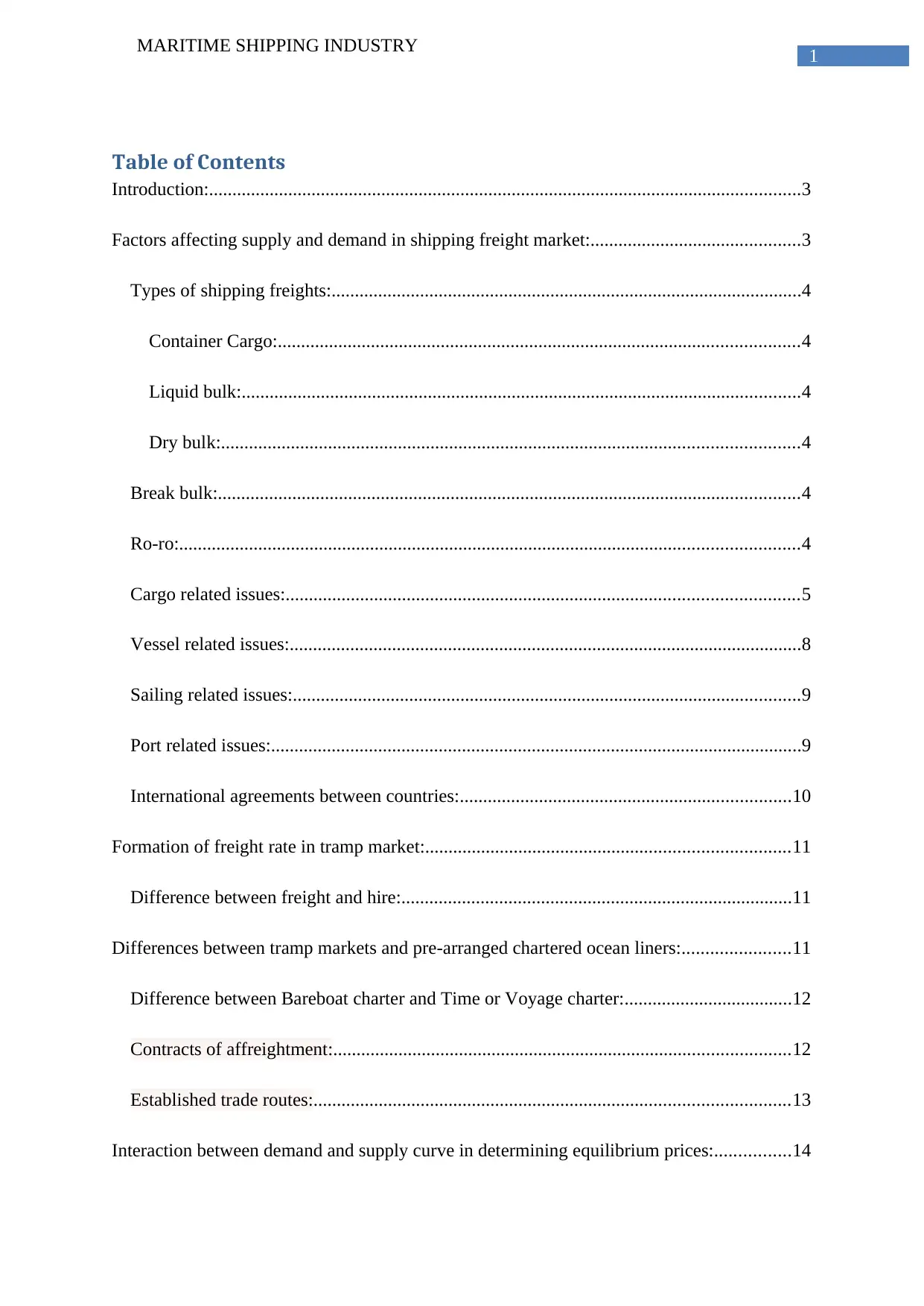
1
MARITIME SHIPPING INDUSTRY
Table of Contents
Introduction:...............................................................................................................................3
Factors affecting supply and demand in shipping freight market:.............................................3
Types of shipping freights:.....................................................................................................4
Container Cargo:................................................................................................................4
Liquid bulk:........................................................................................................................4
Dry bulk:............................................................................................................................4
Break bulk:.............................................................................................................................4
Ro-ro:.....................................................................................................................................4
Cargo related issues:..............................................................................................................5
Vessel related issues:..............................................................................................................8
Sailing related issues:.............................................................................................................9
Port related issues:..................................................................................................................9
International agreements between countries:.......................................................................10
Formation of freight rate in tramp market:..............................................................................11
Difference between freight and hire:....................................................................................11
Differences between tramp markets and pre-arranged chartered ocean liners:.......................11
Difference between Bareboat charter and Time or Voyage charter:....................................12
Contracts of affreightment:..................................................................................................12
Established trade routes:......................................................................................................13
Interaction between demand and supply curve in determining equilibrium prices:................14
MARITIME SHIPPING INDUSTRY
Table of Contents
Introduction:...............................................................................................................................3
Factors affecting supply and demand in shipping freight market:.............................................3
Types of shipping freights:.....................................................................................................4
Container Cargo:................................................................................................................4
Liquid bulk:........................................................................................................................4
Dry bulk:............................................................................................................................4
Break bulk:.............................................................................................................................4
Ro-ro:.....................................................................................................................................4
Cargo related issues:..............................................................................................................5
Vessel related issues:..............................................................................................................8
Sailing related issues:.............................................................................................................9
Port related issues:..................................................................................................................9
International agreements between countries:.......................................................................10
Formation of freight rate in tramp market:..............................................................................11
Difference between freight and hire:....................................................................................11
Differences between tramp markets and pre-arranged chartered ocean liners:.......................11
Difference between Bareboat charter and Time or Voyage charter:....................................12
Contracts of affreightment:..................................................................................................12
Established trade routes:......................................................................................................13
Interaction between demand and supply curve in determining equilibrium prices:................14
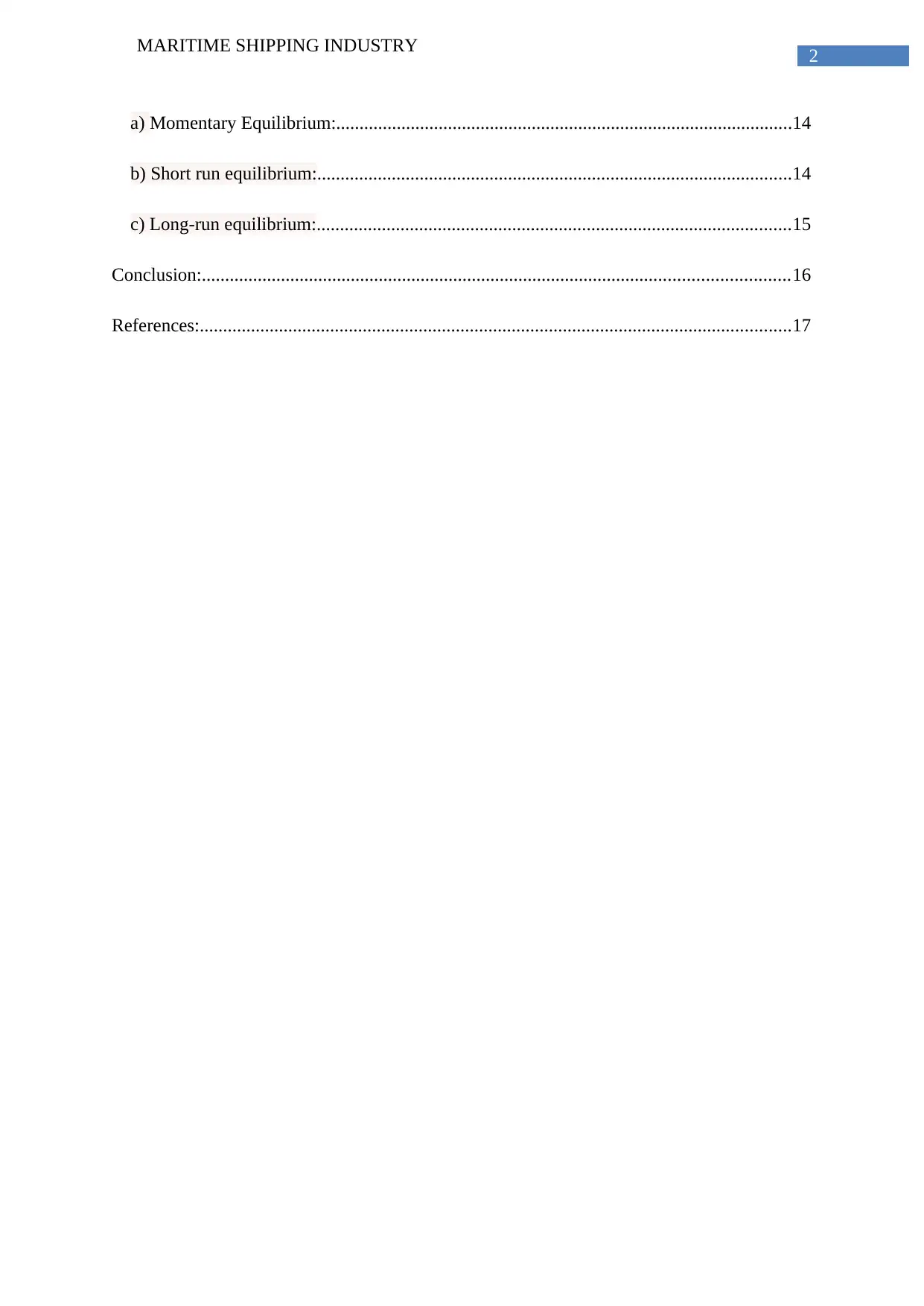
2
MARITIME SHIPPING INDUSTRY
a) Momentary Equilibrium:..................................................................................................14
b) Short run equilibrium:......................................................................................................14
c) Long-run equilibrium:......................................................................................................15
Conclusion:..............................................................................................................................16
References:...............................................................................................................................17
MARITIME SHIPPING INDUSTRY
a) Momentary Equilibrium:..................................................................................................14
b) Short run equilibrium:......................................................................................................14
c) Long-run equilibrium:......................................................................................................15
Conclusion:..............................................................................................................................16
References:...............................................................................................................................17
⊘ This is a preview!⊘
Do you want full access?
Subscribe today to unlock all pages.

Trusted by 1+ million students worldwide
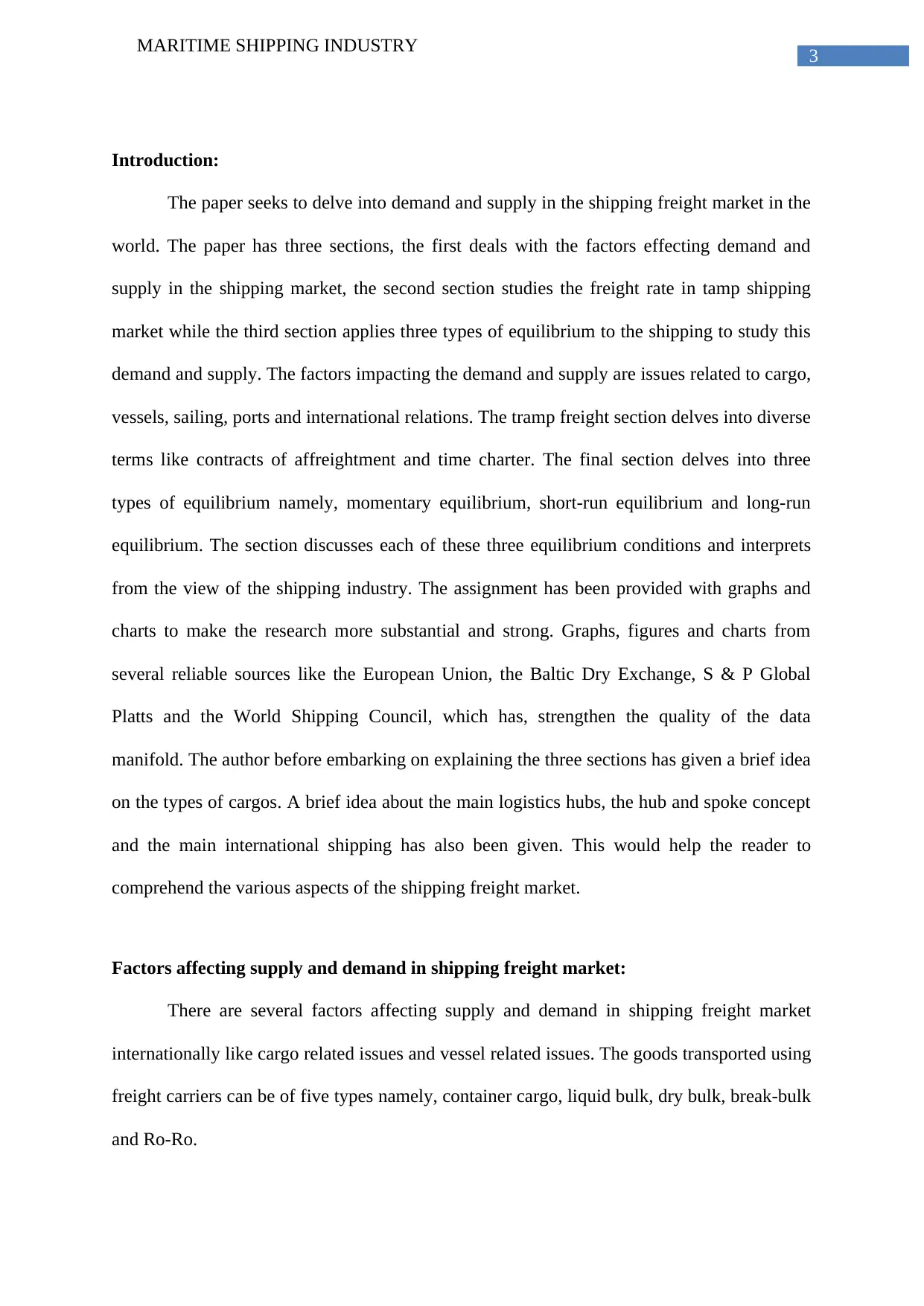
3
MARITIME SHIPPING INDUSTRY
Introduction:
The paper seeks to delve into demand and supply in the shipping freight market in the
world. The paper has three sections, the first deals with the factors effecting demand and
supply in the shipping market, the second section studies the freight rate in tamp shipping
market while the third section applies three types of equilibrium to the shipping to study this
demand and supply. The factors impacting the demand and supply are issues related to cargo,
vessels, sailing, ports and international relations. The tramp freight section delves into diverse
terms like contracts of affreightment and time charter. The final section delves into three
types of equilibrium namely, momentary equilibrium, short-run equilibrium and long-run
equilibrium. The section discusses each of these three equilibrium conditions and interprets
from the view of the shipping industry. The assignment has been provided with graphs and
charts to make the research more substantial and strong. Graphs, figures and charts from
several reliable sources like the European Union, the Baltic Dry Exchange, S & P Global
Platts and the World Shipping Council, which has, strengthen the quality of the data
manifold. The author before embarking on explaining the three sections has given a brief idea
on the types of cargos. A brief idea about the main logistics hubs, the hub and spoke concept
and the main international shipping has also been given. This would help the reader to
comprehend the various aspects of the shipping freight market.
Factors affecting supply and demand in shipping freight market:
There are several factors affecting supply and demand in shipping freight market
internationally like cargo related issues and vessel related issues. The goods transported using
freight carriers can be of five types namely, container cargo, liquid bulk, dry bulk, break-bulk
and Ro-Ro.
MARITIME SHIPPING INDUSTRY
Introduction:
The paper seeks to delve into demand and supply in the shipping freight market in the
world. The paper has three sections, the first deals with the factors effecting demand and
supply in the shipping market, the second section studies the freight rate in tamp shipping
market while the third section applies three types of equilibrium to the shipping to study this
demand and supply. The factors impacting the demand and supply are issues related to cargo,
vessels, sailing, ports and international relations. The tramp freight section delves into diverse
terms like contracts of affreightment and time charter. The final section delves into three
types of equilibrium namely, momentary equilibrium, short-run equilibrium and long-run
equilibrium. The section discusses each of these three equilibrium conditions and interprets
from the view of the shipping industry. The assignment has been provided with graphs and
charts to make the research more substantial and strong. Graphs, figures and charts from
several reliable sources like the European Union, the Baltic Dry Exchange, S & P Global
Platts and the World Shipping Council, which has, strengthen the quality of the data
manifold. The author before embarking on explaining the three sections has given a brief idea
on the types of cargos. A brief idea about the main logistics hubs, the hub and spoke concept
and the main international shipping has also been given. This would help the reader to
comprehend the various aspects of the shipping freight market.
Factors affecting supply and demand in shipping freight market:
There are several factors affecting supply and demand in shipping freight market
internationally like cargo related issues and vessel related issues. The goods transported using
freight carriers can be of five types namely, container cargo, liquid bulk, dry bulk, break-bulk
and Ro-Ro.
Paraphrase This Document
Need a fresh take? Get an instant paraphrase of this document with our AI Paraphraser
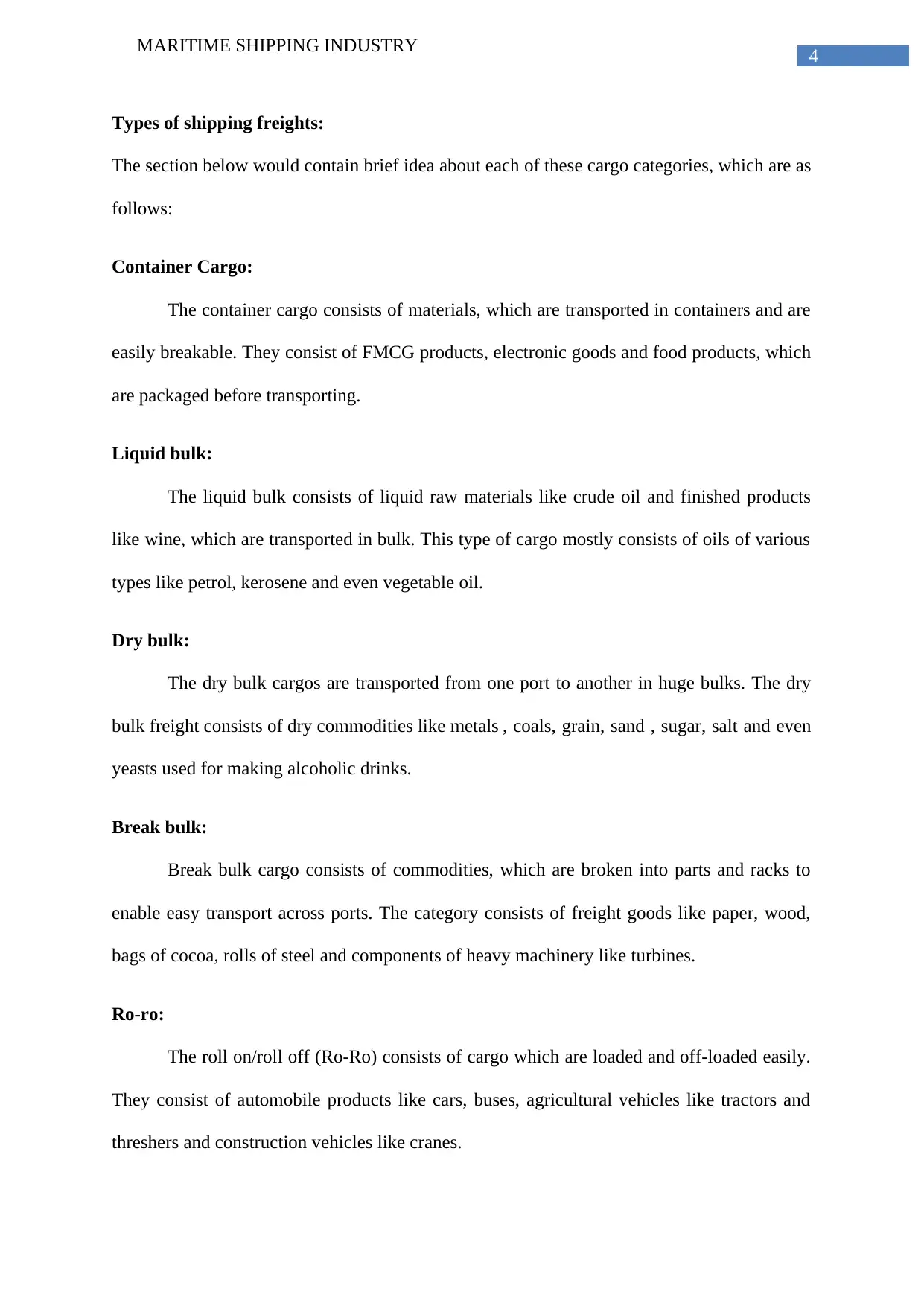
4
MARITIME SHIPPING INDUSTRY
Types of shipping freights:
The section below would contain brief idea about each of these cargo categories, which are as
follows:
Container Cargo:
The container cargo consists of materials, which are transported in containers and are
easily breakable. They consist of FMCG products, electronic goods and food products, which
are packaged before transporting.
Liquid bulk:
The liquid bulk consists of liquid raw materials like crude oil and finished products
like wine, which are transported in bulk. This type of cargo mostly consists of oils of various
types like petrol, kerosene and even vegetable oil.
Dry bulk:
The dry bulk cargos are transported from one port to another in huge bulks. The dry
bulk freight consists of dry commodities like metals , coals, grain, sand , sugar, salt and even
yeasts used for making alcoholic drinks.
Break bulk:
Break bulk cargo consists of commodities, which are broken into parts and racks to
enable easy transport across ports. The category consists of freight goods like paper, wood,
bags of cocoa, rolls of steel and components of heavy machinery like turbines.
Ro-ro:
The roll on/roll off (Ro-Ro) consists of cargo which are loaded and off-loaded easily.
They consist of automobile products like cars, buses, agricultural vehicles like tractors and
threshers and construction vehicles like cranes.
MARITIME SHIPPING INDUSTRY
Types of shipping freights:
The section below would contain brief idea about each of these cargo categories, which are as
follows:
Container Cargo:
The container cargo consists of materials, which are transported in containers and are
easily breakable. They consist of FMCG products, electronic goods and food products, which
are packaged before transporting.
Liquid bulk:
The liquid bulk consists of liquid raw materials like crude oil and finished products
like wine, which are transported in bulk. This type of cargo mostly consists of oils of various
types like petrol, kerosene and even vegetable oil.
Dry bulk:
The dry bulk cargos are transported from one port to another in huge bulks. The dry
bulk freight consists of dry commodities like metals , coals, grain, sand , sugar, salt and even
yeasts used for making alcoholic drinks.
Break bulk:
Break bulk cargo consists of commodities, which are broken into parts and racks to
enable easy transport across ports. The category consists of freight goods like paper, wood,
bags of cocoa, rolls of steel and components of heavy machinery like turbines.
Ro-ro:
The roll on/roll off (Ro-Ro) consists of cargo which are loaded and off-loaded easily.
They consist of automobile products like cars, buses, agricultural vehicles like tractors and
threshers and construction vehicles like cranes.
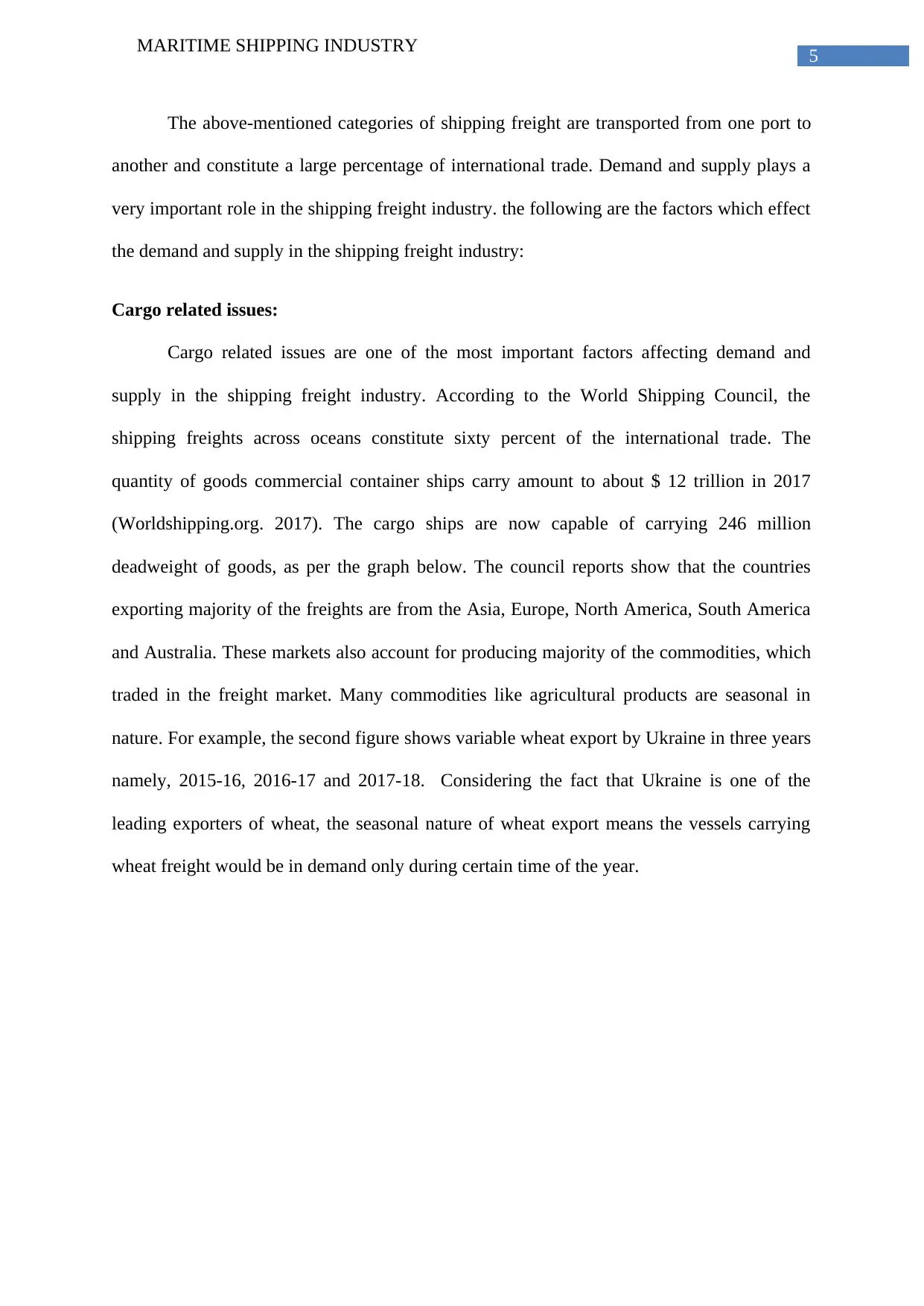
5
MARITIME SHIPPING INDUSTRY
The above-mentioned categories of shipping freight are transported from one port to
another and constitute a large percentage of international trade. Demand and supply plays a
very important role in the shipping freight industry. the following are the factors which effect
the demand and supply in the shipping freight industry:
Cargo related issues:
Cargo related issues are one of the most important factors affecting demand and
supply in the shipping freight industry. According to the World Shipping Council, the
shipping freights across oceans constitute sixty percent of the international trade. The
quantity of goods commercial container ships carry amount to about $ 12 trillion in 2017
(Worldshipping.org. 2017). The cargo ships are now capable of carrying 246 million
deadweight of goods, as per the graph below. The council reports show that the countries
exporting majority of the freights are from the Asia, Europe, North America, South America
and Australia. These markets also account for producing majority of the commodities, which
traded in the freight market. Many commodities like agricultural products are seasonal in
nature. For example, the second figure shows variable wheat export by Ukraine in three years
namely, 2015-16, 2016-17 and 2017-18. Considering the fact that Ukraine is one of the
leading exporters of wheat, the seasonal nature of wheat export means the vessels carrying
wheat freight would be in demand only during certain time of the year.
MARITIME SHIPPING INDUSTRY
The above-mentioned categories of shipping freight are transported from one port to
another and constitute a large percentage of international trade. Demand and supply plays a
very important role in the shipping freight industry. the following are the factors which effect
the demand and supply in the shipping freight industry:
Cargo related issues:
Cargo related issues are one of the most important factors affecting demand and
supply in the shipping freight industry. According to the World Shipping Council, the
shipping freights across oceans constitute sixty percent of the international trade. The
quantity of goods commercial container ships carry amount to about $ 12 trillion in 2017
(Worldshipping.org. 2017). The cargo ships are now capable of carrying 246 million
deadweight of goods, as per the graph below. The council reports show that the countries
exporting majority of the freights are from the Asia, Europe, North America, South America
and Australia. These markets also account for producing majority of the commodities, which
traded in the freight market. Many commodities like agricultural products are seasonal in
nature. For example, the second figure shows variable wheat export by Ukraine in three years
namely, 2015-16, 2016-17 and 2017-18. Considering the fact that Ukraine is one of the
leading exporters of wheat, the seasonal nature of wheat export means the vessels carrying
wheat freight would be in demand only during certain time of the year.
⊘ This is a preview!⊘
Do you want full access?
Subscribe today to unlock all pages.

Trusted by 1+ million students worldwide
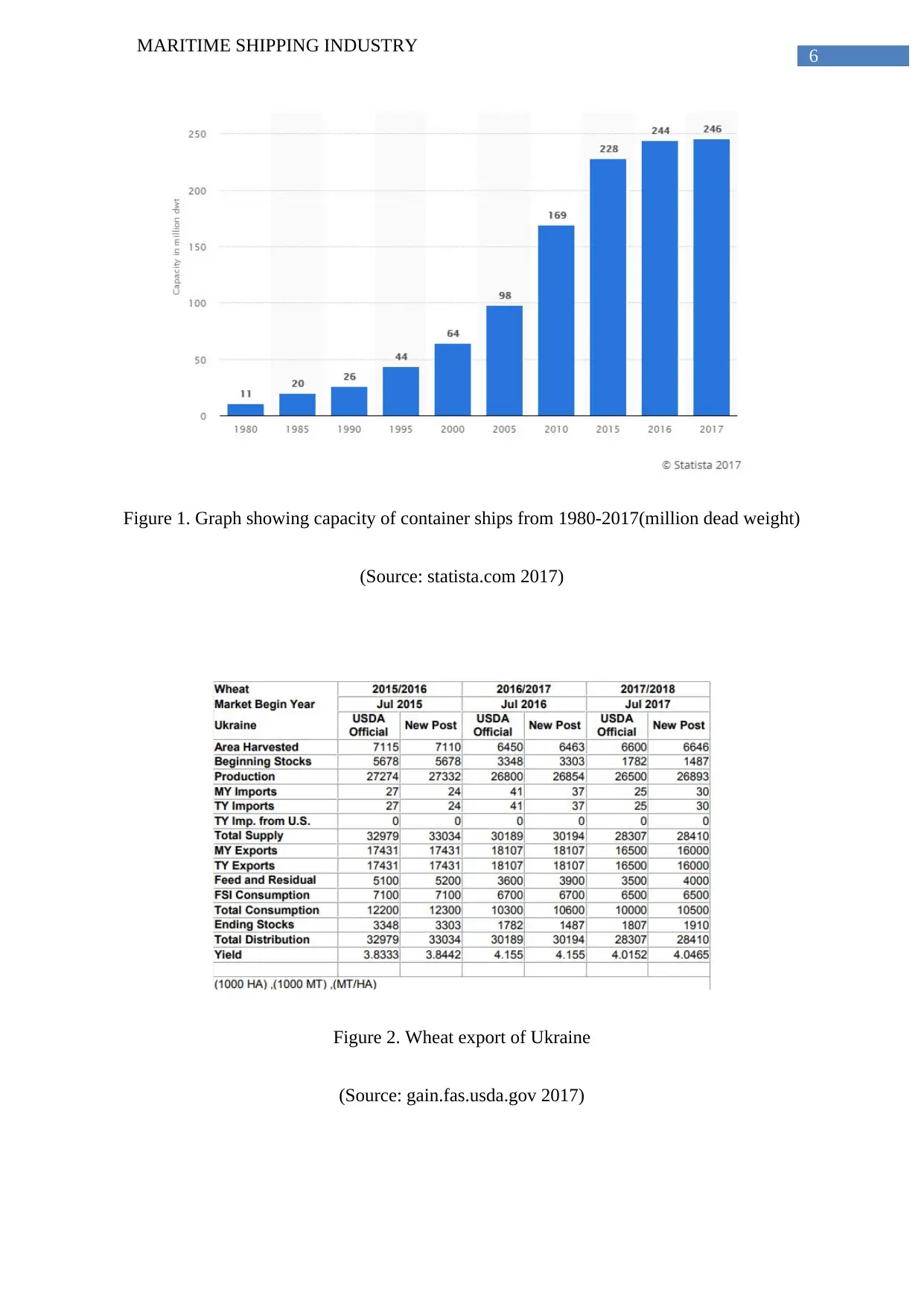
6
MARITIME SHIPPING INDUSTRY
Figure 1. Graph showing capacity of container ships from 1980-2017(million dead weight)
(Source: statista.com 2017)
Figure 2. Wheat export of Ukraine
(Source: gain.fas.usda.gov 2017)
MARITIME SHIPPING INDUSTRY
Figure 1. Graph showing capacity of container ships from 1980-2017(million dead weight)
(Source: statista.com 2017)
Figure 2. Wheat export of Ukraine
(Source: gain.fas.usda.gov 2017)
Paraphrase This Document
Need a fresh take? Get an instant paraphrase of this document with our AI Paraphraser
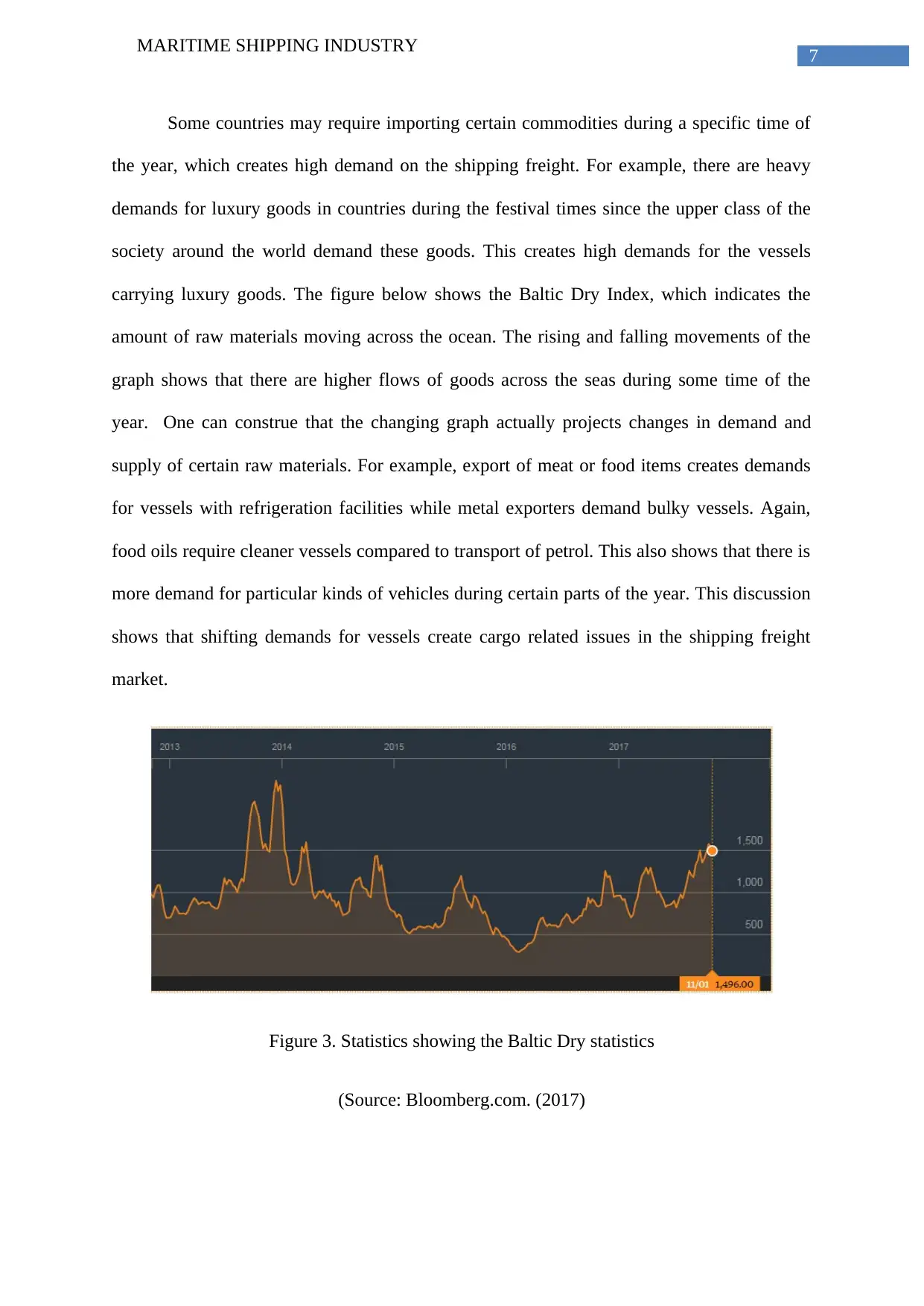
7
MARITIME SHIPPING INDUSTRY
Some countries may require importing certain commodities during a specific time of
the year, which creates high demand on the shipping freight. For example, there are heavy
demands for luxury goods in countries during the festival times since the upper class of the
society around the world demand these goods. This creates high demands for the vessels
carrying luxury goods. The figure below shows the Baltic Dry Index, which indicates the
amount of raw materials moving across the ocean. The rising and falling movements of the
graph shows that there are higher flows of goods across the seas during some time of the
year. One can construe that the changing graph actually projects changes in demand and
supply of certain raw materials. For example, export of meat or food items creates demands
for vessels with refrigeration facilities while metal exporters demand bulky vessels. Again,
food oils require cleaner vessels compared to transport of petrol. This also shows that there is
more demand for particular kinds of vehicles during certain parts of the year. This discussion
shows that shifting demands for vessels create cargo related issues in the shipping freight
market.
Figure 3. Statistics showing the Baltic Dry statistics
(Source: Bloomberg.com. (2017)
MARITIME SHIPPING INDUSTRY
Some countries may require importing certain commodities during a specific time of
the year, which creates high demand on the shipping freight. For example, there are heavy
demands for luxury goods in countries during the festival times since the upper class of the
society around the world demand these goods. This creates high demands for the vessels
carrying luxury goods. The figure below shows the Baltic Dry Index, which indicates the
amount of raw materials moving across the ocean. The rising and falling movements of the
graph shows that there are higher flows of goods across the seas during some time of the
year. One can construe that the changing graph actually projects changes in demand and
supply of certain raw materials. For example, export of meat or food items creates demands
for vessels with refrigeration facilities while metal exporters demand bulky vessels. Again,
food oils require cleaner vessels compared to transport of petrol. This also shows that there is
more demand for particular kinds of vehicles during certain parts of the year. This discussion
shows that shifting demands for vessels create cargo related issues in the shipping freight
market.
Figure 3. Statistics showing the Baltic Dry statistics
(Source: Bloomberg.com. (2017)
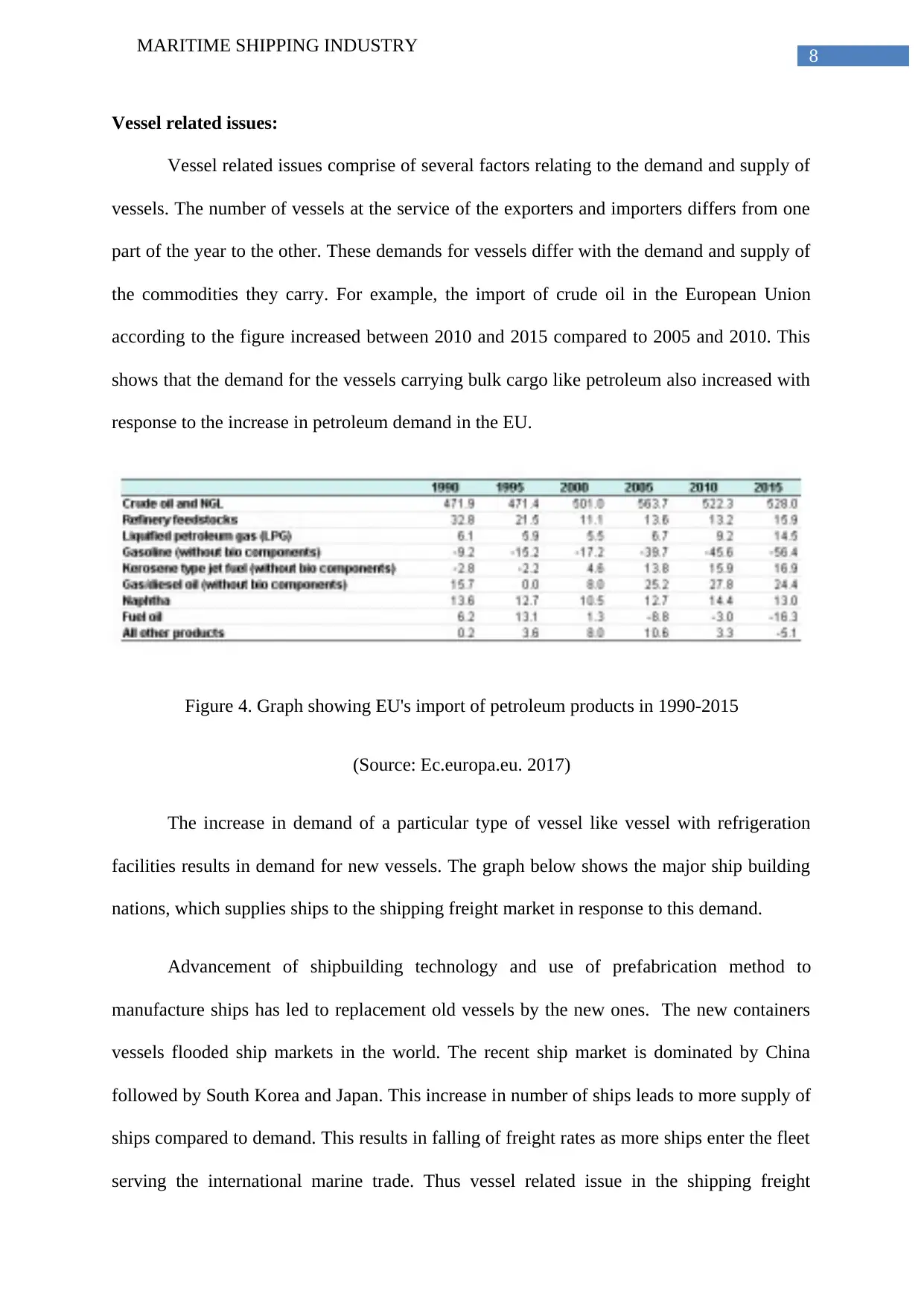
8
MARITIME SHIPPING INDUSTRY
Vessel related issues:
Vessel related issues comprise of several factors relating to the demand and supply of
vessels. The number of vessels at the service of the exporters and importers differs from one
part of the year to the other. These demands for vessels differ with the demand and supply of
the commodities they carry. For example, the import of crude oil in the European Union
according to the figure increased between 2010 and 2015 compared to 2005 and 2010. This
shows that the demand for the vessels carrying bulk cargo like petroleum also increased with
response to the increase in petroleum demand in the EU.
Figure 4. Graph showing EU's import of petroleum products in 1990-2015
(Source: Ec.europa.eu. 2017)
The increase in demand of a particular type of vessel like vessel with refrigeration
facilities results in demand for new vessels. The graph below shows the major ship building
nations, which supplies ships to the shipping freight market in response to this demand.
Advancement of shipbuilding technology and use of prefabrication method to
manufacture ships has led to replacement old vessels by the new ones. The new containers
vessels flooded ship markets in the world. The recent ship market is dominated by China
followed by South Korea and Japan. This increase in number of ships leads to more supply of
ships compared to demand. This results in falling of freight rates as more ships enter the fleet
serving the international marine trade. Thus vessel related issue in the shipping freight
MARITIME SHIPPING INDUSTRY
Vessel related issues:
Vessel related issues comprise of several factors relating to the demand and supply of
vessels. The number of vessels at the service of the exporters and importers differs from one
part of the year to the other. These demands for vessels differ with the demand and supply of
the commodities they carry. For example, the import of crude oil in the European Union
according to the figure increased between 2010 and 2015 compared to 2005 and 2010. This
shows that the demand for the vessels carrying bulk cargo like petroleum also increased with
response to the increase in petroleum demand in the EU.
Figure 4. Graph showing EU's import of petroleum products in 1990-2015
(Source: Ec.europa.eu. 2017)
The increase in demand of a particular type of vessel like vessel with refrigeration
facilities results in demand for new vessels. The graph below shows the major ship building
nations, which supplies ships to the shipping freight market in response to this demand.
Advancement of shipbuilding technology and use of prefabrication method to
manufacture ships has led to replacement old vessels by the new ones. The new containers
vessels flooded ship markets in the world. The recent ship market is dominated by China
followed by South Korea and Japan. This increase in number of ships leads to more supply of
ships compared to demand. This results in falling of freight rates as more ships enter the fleet
serving the international marine trade. Thus vessel related issue in the shipping freight
⊘ This is a preview!⊘
Do you want full access?
Subscribe today to unlock all pages.

Trusted by 1+ million students worldwide
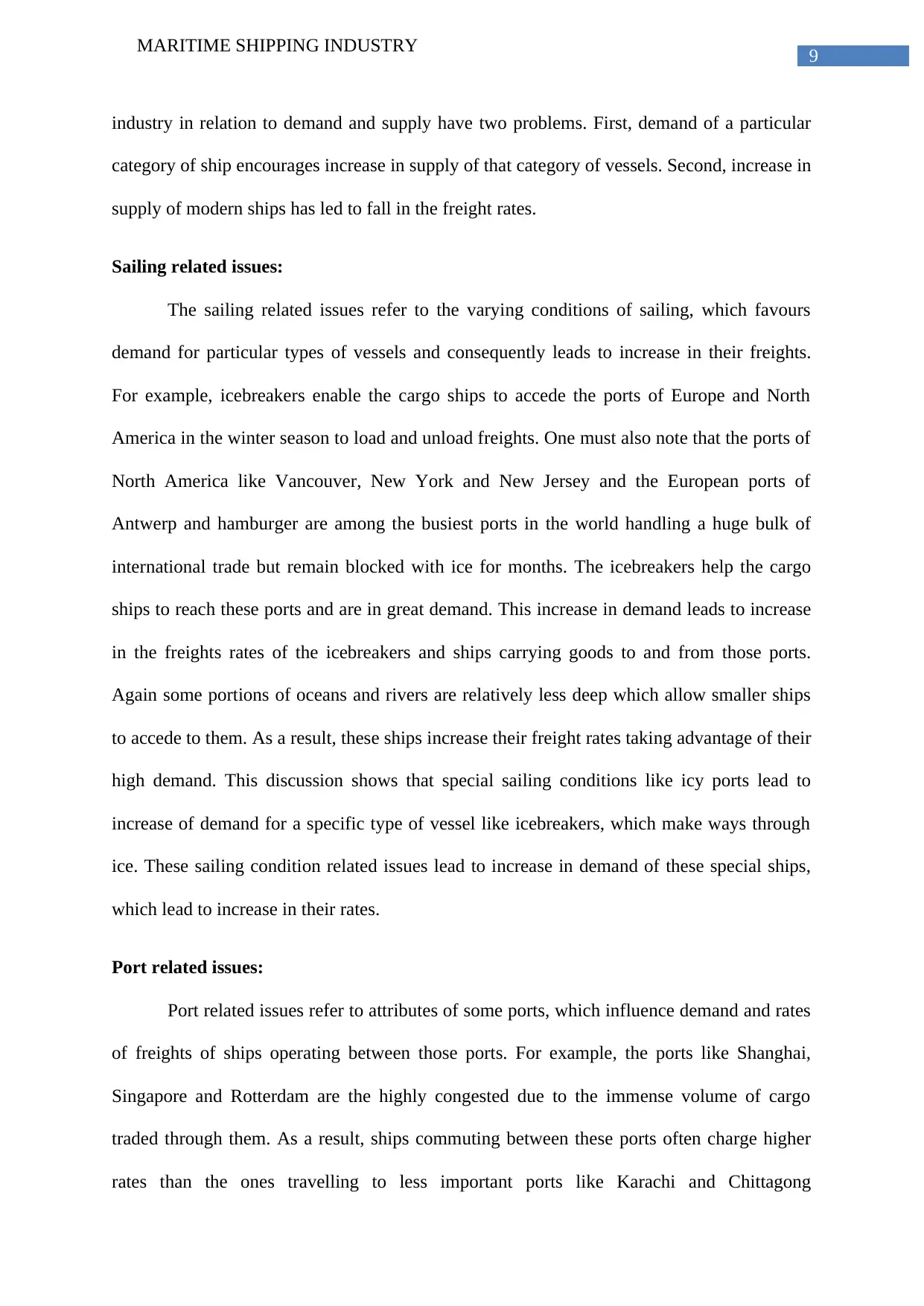
9
MARITIME SHIPPING INDUSTRY
industry in relation to demand and supply have two problems. First, demand of a particular
category of ship encourages increase in supply of that category of vessels. Second, increase in
supply of modern ships has led to fall in the freight rates.
Sailing related issues:
The sailing related issues refer to the varying conditions of sailing, which favours
demand for particular types of vessels and consequently leads to increase in their freights.
For example, icebreakers enable the cargo ships to accede the ports of Europe and North
America in the winter season to load and unload freights. One must also note that the ports of
North America like Vancouver, New York and New Jersey and the European ports of
Antwerp and hamburger are among the busiest ports in the world handling a huge bulk of
international trade but remain blocked with ice for months. The icebreakers help the cargo
ships to reach these ports and are in great demand. This increase in demand leads to increase
in the freights rates of the icebreakers and ships carrying goods to and from those ports.
Again some portions of oceans and rivers are relatively less deep which allow smaller ships
to accede to them. As a result, these ships increase their freight rates taking advantage of their
high demand. This discussion shows that special sailing conditions like icy ports lead to
increase of demand for a specific type of vessel like icebreakers, which make ways through
ice. These sailing condition related issues lead to increase in demand of these special ships,
which lead to increase in their rates.
Port related issues:
Port related issues refer to attributes of some ports, which influence demand and rates
of freights of ships operating between those ports. For example, the ports like Shanghai,
Singapore and Rotterdam are the highly congested due to the immense volume of cargo
traded through them. As a result, ships commuting between these ports often charge higher
rates than the ones travelling to less important ports like Karachi and Chittagong
MARITIME SHIPPING INDUSTRY
industry in relation to demand and supply have two problems. First, demand of a particular
category of ship encourages increase in supply of that category of vessels. Second, increase in
supply of modern ships has led to fall in the freight rates.
Sailing related issues:
The sailing related issues refer to the varying conditions of sailing, which favours
demand for particular types of vessels and consequently leads to increase in their freights.
For example, icebreakers enable the cargo ships to accede the ports of Europe and North
America in the winter season to load and unload freights. One must also note that the ports of
North America like Vancouver, New York and New Jersey and the European ports of
Antwerp and hamburger are among the busiest ports in the world handling a huge bulk of
international trade but remain blocked with ice for months. The icebreakers help the cargo
ships to reach these ports and are in great demand. This increase in demand leads to increase
in the freights rates of the icebreakers and ships carrying goods to and from those ports.
Again some portions of oceans and rivers are relatively less deep which allow smaller ships
to accede to them. As a result, these ships increase their freight rates taking advantage of their
high demand. This discussion shows that special sailing conditions like icy ports lead to
increase of demand for a specific type of vessel like icebreakers, which make ways through
ice. These sailing condition related issues lead to increase in demand of these special ships,
which lead to increase in their rates.
Port related issues:
Port related issues refer to attributes of some ports, which influence demand and rates
of freights of ships operating between those ports. For example, the ports like Shanghai,
Singapore and Rotterdam are the highly congested due to the immense volume of cargo
traded through them. As a result, ships commuting between these ports often charge higher
rates than the ones travelling to less important ports like Karachi and Chittagong
Paraphrase This Document
Need a fresh take? Get an instant paraphrase of this document with our AI Paraphraser
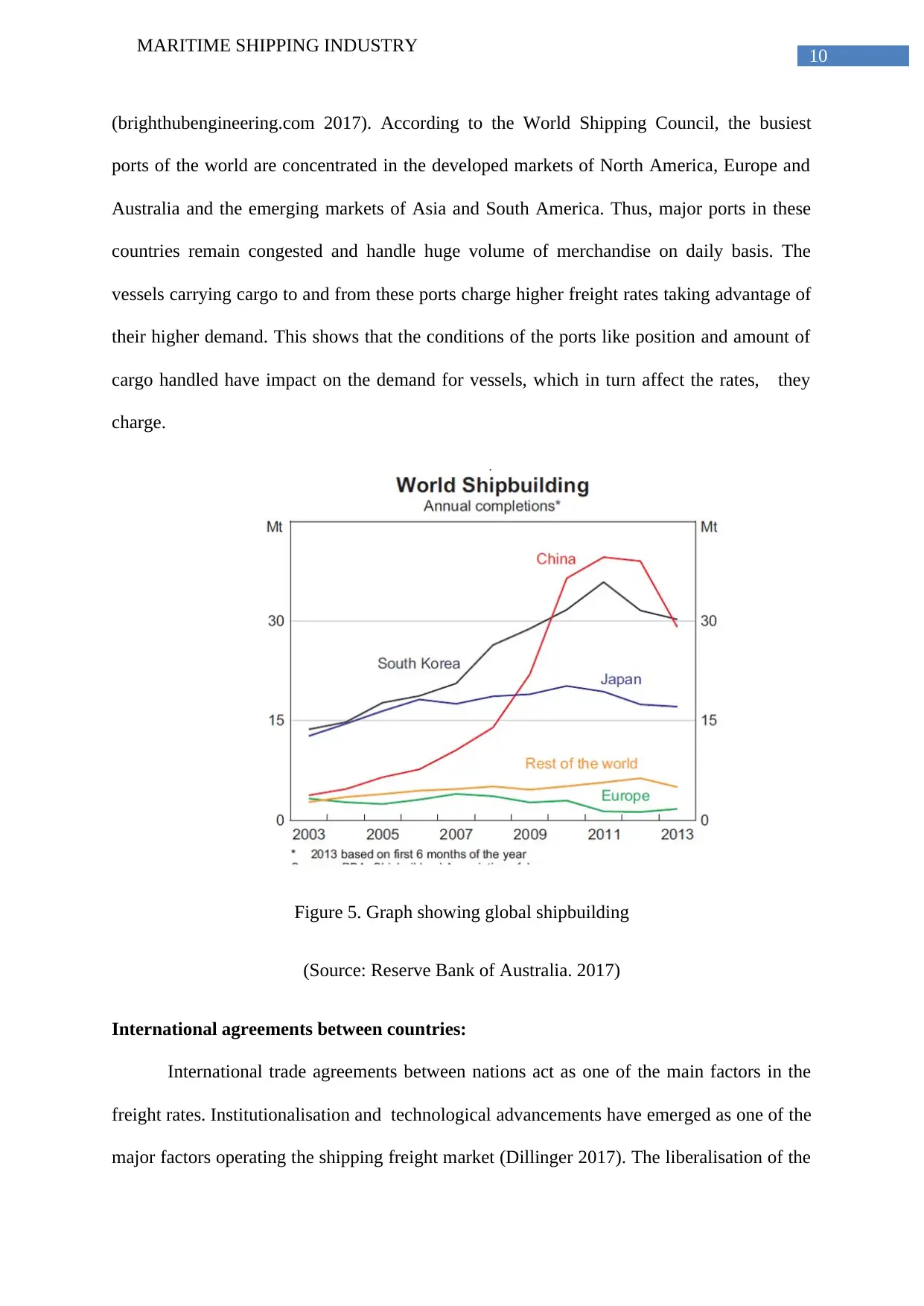
10
MARITIME SHIPPING INDUSTRY
(brighthubengineering.com 2017). According to the World Shipping Council, the busiest
ports of the world are concentrated in the developed markets of North America, Europe and
Australia and the emerging markets of Asia and South America. Thus, major ports in these
countries remain congested and handle huge volume of merchandise on daily basis. The
vessels carrying cargo to and from these ports charge higher freight rates taking advantage of
their higher demand. This shows that the conditions of the ports like position and amount of
cargo handled have impact on the demand for vessels, which in turn affect the rates, they
charge.
Figure 5. Graph showing global shipbuilding
(Source: Reserve Bank of Australia. 2017)
International agreements between countries:
International trade agreements between nations act as one of the main factors in the
freight rates. Institutionalisation and technological advancements have emerged as one of the
major factors operating the shipping freight market (Dillinger 2017). The liberalisation of the
MARITIME SHIPPING INDUSTRY
(brighthubengineering.com 2017). According to the World Shipping Council, the busiest
ports of the world are concentrated in the developed markets of North America, Europe and
Australia and the emerging markets of Asia and South America. Thus, major ports in these
countries remain congested and handle huge volume of merchandise on daily basis. The
vessels carrying cargo to and from these ports charge higher freight rates taking advantage of
their higher demand. This shows that the conditions of the ports like position and amount of
cargo handled have impact on the demand for vessels, which in turn affect the rates, they
charge.
Figure 5. Graph showing global shipbuilding
(Source: Reserve Bank of Australia. 2017)
International agreements between countries:
International trade agreements between nations act as one of the main factors in the
freight rates. Institutionalisation and technological advancements have emerged as one of the
major factors operating the shipping freight market (Dillinger 2017). The liberalisation of the
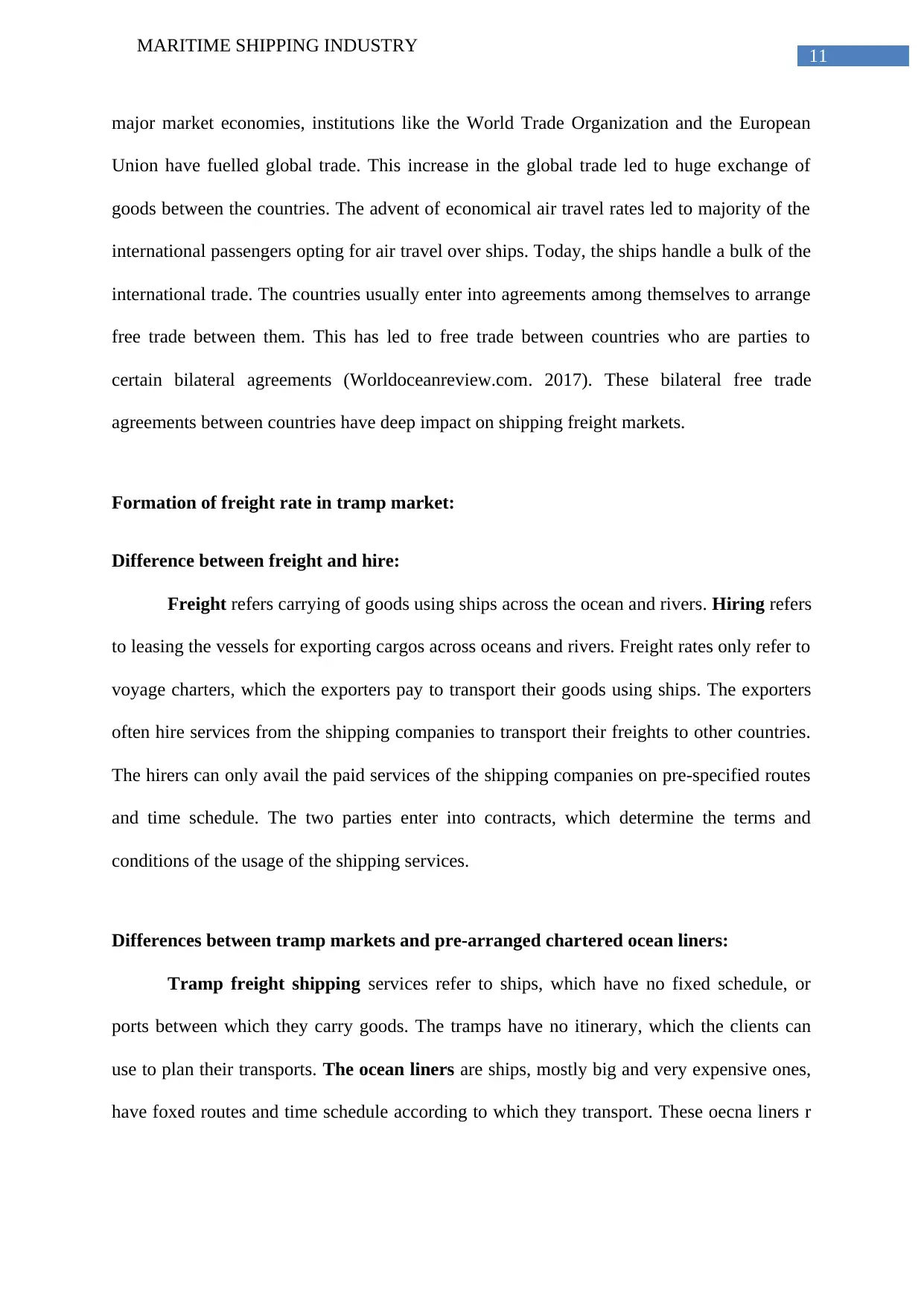
11
MARITIME SHIPPING INDUSTRY
major market economies, institutions like the World Trade Organization and the European
Union have fuelled global trade. This increase in the global trade led to huge exchange of
goods between the countries. The advent of economical air travel rates led to majority of the
international passengers opting for air travel over ships. Today, the ships handle a bulk of the
international trade. The countries usually enter into agreements among themselves to arrange
free trade between them. This has led to free trade between countries who are parties to
certain bilateral agreements (Worldoceanreview.com. 2017). These bilateral free trade
agreements between countries have deep impact on shipping freight markets.
Formation of freight rate in tramp market:
Difference between freight and hire:
Freight refers carrying of goods using ships across the ocean and rivers. Hiring refers
to leasing the vessels for exporting cargos across oceans and rivers. Freight rates only refer to
voyage charters, which the exporters pay to transport their goods using ships. The exporters
often hire services from the shipping companies to transport their freights to other countries.
The hirers can only avail the paid services of the shipping companies on pre-specified routes
and time schedule. The two parties enter into contracts, which determine the terms and
conditions of the usage of the shipping services.
Differences between tramp markets and pre-arranged chartered ocean liners:
Tramp freight shipping services refer to ships, which have no fixed schedule, or
ports between which they carry goods. The tramps have no itinerary, which the clients can
use to plan their transports. The ocean liners are ships, mostly big and very expensive ones,
have foxed routes and time schedule according to which they transport. These oecna liners r
MARITIME SHIPPING INDUSTRY
major market economies, institutions like the World Trade Organization and the European
Union have fuelled global trade. This increase in the global trade led to huge exchange of
goods between the countries. The advent of economical air travel rates led to majority of the
international passengers opting for air travel over ships. Today, the ships handle a bulk of the
international trade. The countries usually enter into agreements among themselves to arrange
free trade between them. This has led to free trade between countries who are parties to
certain bilateral agreements (Worldoceanreview.com. 2017). These bilateral free trade
agreements between countries have deep impact on shipping freight markets.
Formation of freight rate in tramp market:
Difference between freight and hire:
Freight refers carrying of goods using ships across the ocean and rivers. Hiring refers
to leasing the vessels for exporting cargos across oceans and rivers. Freight rates only refer to
voyage charters, which the exporters pay to transport their goods using ships. The exporters
often hire services from the shipping companies to transport their freights to other countries.
The hirers can only avail the paid services of the shipping companies on pre-specified routes
and time schedule. The two parties enter into contracts, which determine the terms and
conditions of the usage of the shipping services.
Differences between tramp markets and pre-arranged chartered ocean liners:
Tramp freight shipping services refer to ships, which have no fixed schedule, or
ports between which they carry goods. The tramps have no itinerary, which the clients can
use to plan their transports. The ocean liners are ships, mostly big and very expensive ones,
have foxed routes and time schedule according to which they transport. These oecna liners r
⊘ This is a preview!⊘
Do you want full access?
Subscribe today to unlock all pages.

Trusted by 1+ million students worldwide
1 out of 21
Related Documents
Your All-in-One AI-Powered Toolkit for Academic Success.
+13062052269
info@desklib.com
Available 24*7 on WhatsApp / Email
![[object Object]](/_next/static/media/star-bottom.7253800d.svg)
Unlock your academic potential
Copyright © 2020–2025 A2Z Services. All Rights Reserved. Developed and managed by ZUCOL.




